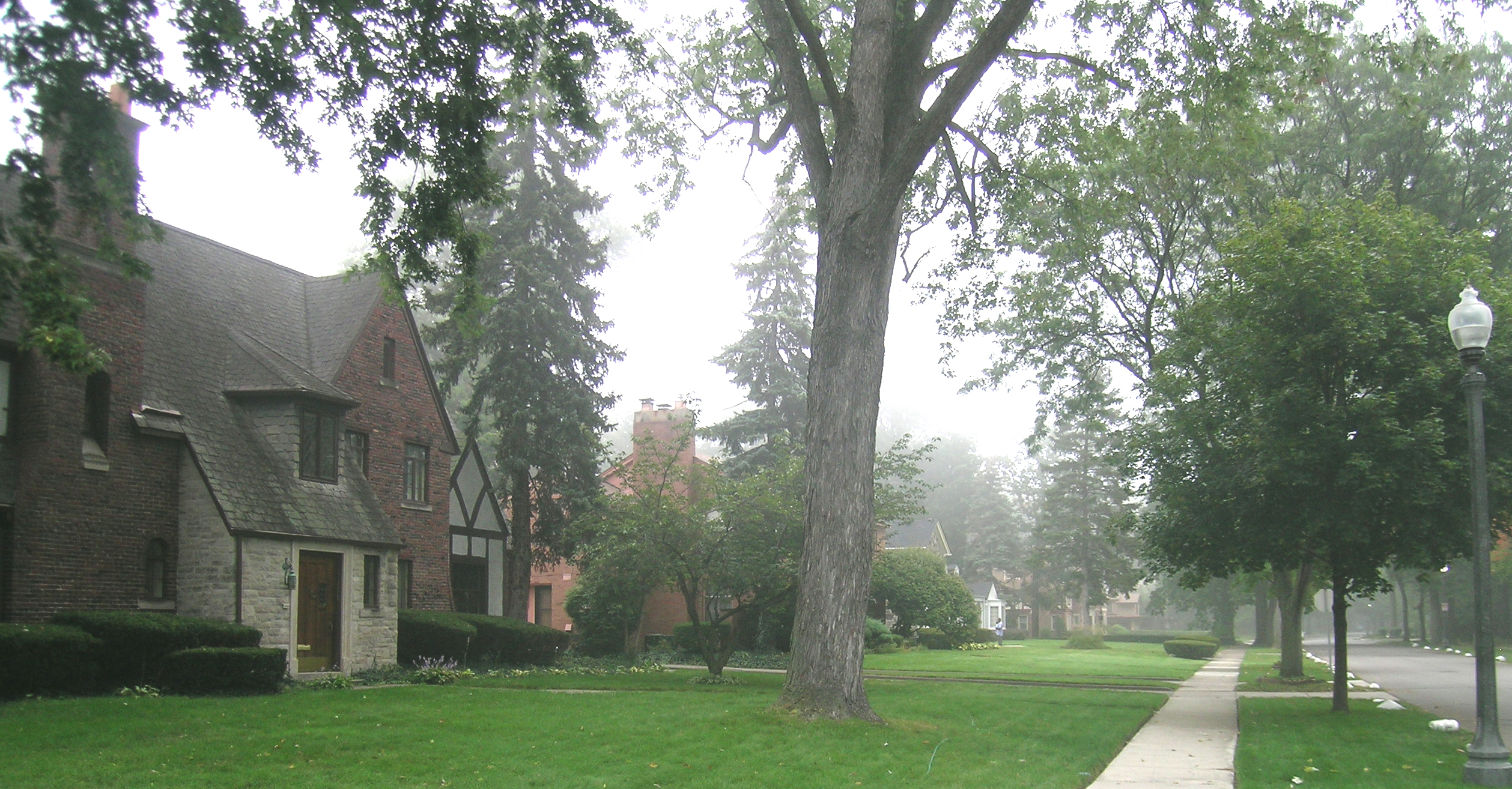- Palmer Woods Historic District
Infobox_nrhp | name =Palmer Woods Historic District
nrhp_type = hd

caption = Streetscape along Strathcona
location=Detroit, Michigan
lat_degrees = 42
lat_minutes = 26
lat_seconds = 5
lat_direction = N
long_degrees = 83
long_minutes = 7
long_seconds = 28
long_direction = W
locmapin = Michigan
area =
built =1915
architect= Multiple
architecture=Colonial Revival ,Tudor Revival
added = August 11, 1983
governing_body = Private
refnum=83000896cite web|url=http://www.nr.nps.gov/|title=National Register Information System|date=2008-04-15|work=National Register of Historic Places|publisher=National Park Service]The Palmer Woods Historic District is a residential historic district bounded by Seven Mile Road,
Woodward Avenue , and Strathcona Drive inDetroit ,Michigan . There are approximately 289 homes in the 188-acre district.Neighborhood character
Palmer Woods is known for its elm-lined streets, large brick and stone homes in
Tudor style architecture, set back from the street behind contiguous uninterruptedlawn . Lots are large, with ample room for trees, play equipment, and a good expanse of grass. There may be Scottish coats of arms, leaded stained glass windows, and other features, such as elevators in some of the homes. Some of the properties boast more than one structure: such as a house and guest house, or maids' quarters. Streets gently curve through the forested neighborhood.History
The Palmer Woods Historic District is maned after
Thomas W. Palmer , a prominent citizen of nineteenth-century Detroit and a United States Senator. Palmer's estate included land on both sides ofWoodward Avenue , stretching from Six Mile Road to Eight Mile Road. [http://detroit1701.org/PalmerWoods_Hist.htm Palmer Woods Historic District] from Detroit1701.org] During his lifetime, Palmer donated some of his acreage to the city of Detroit to establish Palmer Park, and gave additional acreage to the state of Michigan to build theMichigan State Fairgrounds .Palmer died in 1913; two years later, Detroit real-estate developer Charles W. Burton purchased the section of Palmer's estate that now encompasses the Palmer Woods Historic District. Burton envisioned an exclusive neighborhood, catering to Detroit's richest citizens, with room for spacious and elegent homes. He hired the landscape architect
Ossian Cole Simonds to design the layout of the development. Cole laid out a subdivision with gently curving streets, capitalizing on the natural beauty of the area and creating a parklike atmosphere in the neighborhood. Curbs are nonexistant, minimizing the transition from street to lawn and discouraging pedestrian traffic, and every lot in the neighborhood had a unique shape. The neighborhood received the Michigan Horticultural Society's Award of Merit in 1938 for being the finest platted subdivision in Michigan. [http://www.nps.gov/history/nR/travel/detroit/d34.htm Palmer Woods Historic District] from the National Park Service]Most of the homes in Palmer Woods were constructed between about 1917 and 1929. Many of these homes are in
Colonial Revival andTudor Revival styles. However, even by theGreat Depression some lots remained unused, and additional mansions were constructed afterWW II . The most recent house was completed in 1956.Residents
The Palmer Woods neighborhood attracted some of Detroit's most prominent citizens. Charles W. Burton himself made his home in the neighborhood. Two of the seven Fisher Brothers (owners of
Fisher Body ), Alfred and William, also lived in the neighborhood. William Fisher's house, on Wellesley, is 35,000 square feet, one of the largest in Detroit.John H. Kunsky , the founder ofUnited Artists theatres, also lived in the area.Homes
Almost every house in Palmer Woods has unique architectural features, but a number are particularly important. At the southern edge of the district is the only house in Detroit designed by
Frank Lloyd Wright .C. Howard Crane , the noted theater architect, designed the home of John H. Kunsky, incorporating many theater elements into the design.Minoru Yamasaki andLeonard Willeke also designed houses in the district.Bishop Gallagher House
Probably the most significant home in the district is the Bishop Gallagher residence. The home was built for the Fisher Brothers in 1925, who hired the Boston firm of McGinnis and Walsh, specialists in ecclesiastical architecture, to design it. [http://detroit1701.org/BishopRes.htm Bishop's Residence] form Detroit1701.org] Upon completion, the Fishers gave the mansion to Bishop Michael Gallagher, of the
Roman Catholic Archdiocese of Detroit . The 40,000 square foot home is the largest in Detroit.The two-story brick residence, a large central structure flanked by diagonal wings. There are numerous exterior bays, each topped with a parapet capped with masonry and a finial. Religious themes are included throughout the house, both on the exterior and the interior. On the exterior, medallions, shields and crests are set into the brickwork, and a copper statue of the archangel St. Michael fighting Satan is prominent. The interior is finished with oak, stone and masonry. The house had, at one time, the largest collection of Pewabic glazed pottery tile in Michigan.
Bishop Gallagher lived in this home until his death in 1937. Subsequent archbishops of Detroit
Edward Cardinal Mooney andJohn Cardinal Dearden also lived in the home. Upon Cardinal Dearden's death, the archdiocese sold the house toJohn Salley of theDetroit Pistons .Palmer Woods today
While "
white flight " as well as an outbreak ofDutch Elm disease in the 1970s took some of the luster off the fashionable community, it is still the home of physicians, politicians, business owners, artists, executives and their families. Palmer Woods has its own security service and an active voluntary neighborhood association.External links
* [http://www.palmerwoods.org/ Palmer Woods] Home Page
References
Wikimedia Foundation. 2010.
